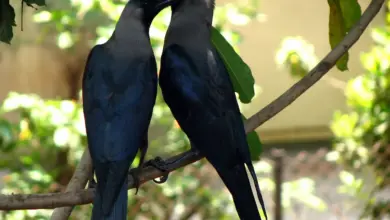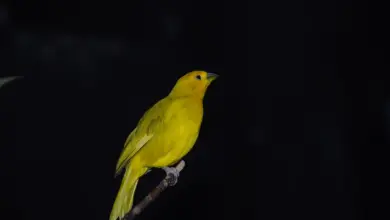Hummingbirds found in Mississippi USA
Hummingbirds found in the USA (by U.S. State) … Canada … Mexico … Puerto Rico … Jamaica … Honduras
Hummingbirds found in Mississippi USA
Hummingbird Information … Hummingbird Species Photo Gallery
The following listed (with photos) are hummingbird species that have been reported in Mississippi.
Ruby-throated Hummingbirds (Archilochus colubris) are Common breeders. According to the US Department of Agriculture, the ruby-throated hummingbird is the only hummingbird that breeds east of the Mississippi River. Summer breeder. Migrates south to their wintering territories by late summer. Usually arrive in mid-April, although some come as early as mid-March. Mating and nesting usually occur in June. They usually return to their wintering grounds in Mexico and Central America by late July. Some of them migrate south later, but usually, they are all gone by October.
The male has a ruby-red throat, a white collar, an emerald green back, and a forked tail.
The female has a green back and tail feathers that are banded white, black, and grey-green.
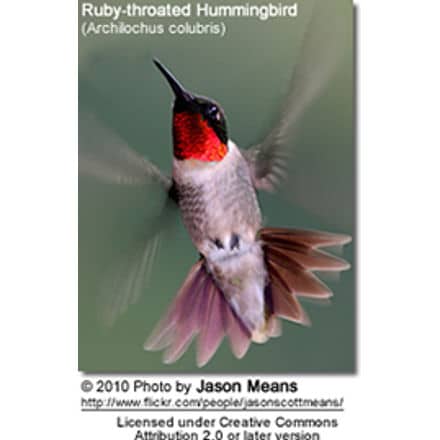
Rufous Hummingbirds (Selasphorus rufus) – Seasonal (non-breeding) visitors
These hummingbirds are usually found in gardens and feeders. These birds are fearless and are known for chasing away other hummingbirds and even larger birds, or rodents away from their favorite nectar feeders and flowers.
Males can easily be identified by their glossy orange-red throats.
Females have whitish, speckled throats, green backs and crowns, and rufous, white-tipped tail feathers.
Rufous Hummingbird versus the similar Ruby-throated Hummingbird (Identification)
Anna’s Hummingbirds (Calypte anna)
One of the larger and the most vocal hummingbirds in the United States, it is the only species to produce a song; specifically the males produce a complex series of scratchy noises, sounding like a sharp “chee-chee-chee; when moving from flower to flower, they emit toneless “chip” vocalizations. All other hummingbirds in the United States are mostly silent.
They are well known for their territorial behavior; the male makes elaborate dive displays at other birds and sometimes even at people. At the bottom of their dives, they produce high-pitched loud popping sounds with their tail feathers.
Males have glossy dark rose-red throats and crowns, which may appear black or dark purple in low light. The underside is mostly greyish; and the back metallic green.
Females have light grey chests with white and red spotting on the throat, greenish back and white tipped tails.
They resemble the Costa’s Hummingbirds, but the male Costa’s Hummingbird‘s gorget (throat feathers) is longer than that of the Anna’s. They are larger than the Rufous Hummingbirds and lack the rusty coloration of the Rufous Hummingbirds.
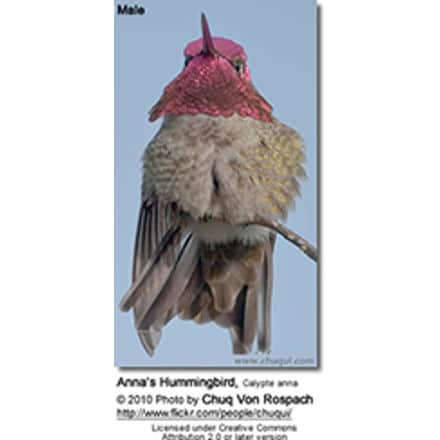
Allen’s Hummingbirds (Selasphorus sasin) – Rare vagrants – The Allen’s Hummingbird is often confused with the Rufous Hummingbird, but the Allen’s can be identified by the green back whereas the Rufous Hummingbird has a coppery back.
The male has a throat that ranges in color from orange-red to yellow-orange, a back that is bright green, a rump that is rufous and its tail feathers are rufous tipped in black.

(Amazilia yucatanensis) – Wintering birds – Occur in fall, winter and spring
The male’s throat is a metallic golden green and the red, dark-tipped bill is straight and slender. Back and head are mostly metallic olive. The lower chest ranges in coloration to whitish with various shades of grey or green, or buffy (yellowish-brown).
The tail and primary wing feathers are rufous (reddish-brown) and slightly forked. The underwing is white.
The female is generally less colorful than the male and has a a dark upper bill
Black-chinned Hummingbirds (Archilochus alexandri) – Rare visitors
The male has a black, shimmering throat with a purple edge and pale feathers below that create a collar. However, unless the light is just right, the head looks all black. His back is green and there are some green feathers covering the chest.
The female is pale below (sometimes with a slightly speckled throat) and her back is green.
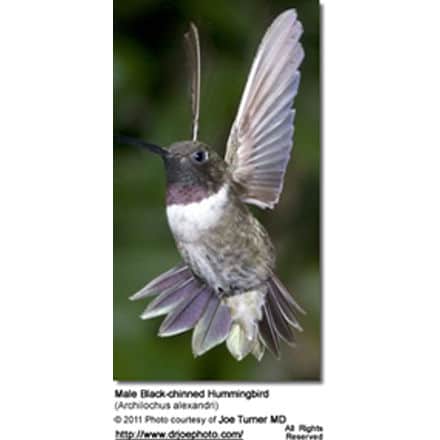
Broad-tailed Hummingbird, Selasphorus platycercus – Rare – Migratory hummingbirds breed across mountain forests and meadows throughout the Western United States from eastern California and northern Wyoming south through Great Basin and Rocky Mountain states to southern Arizona and western Texas. Move south to winter in Mexico, Guatemala and, occasionally, El Salvador.
Males can most easily be identified by their iridescent, rose-red throats, white chest feathers and metallic green back and crown and their rounded tails. The males’ tails make whistling noises in flight.
Females lack the flashy throat patch of the male and are mostly pale below. Their white-tipped outer tail feathers are rust-colored close to the body and blackish in the center; the tail feathers in the center range from green to blackish.
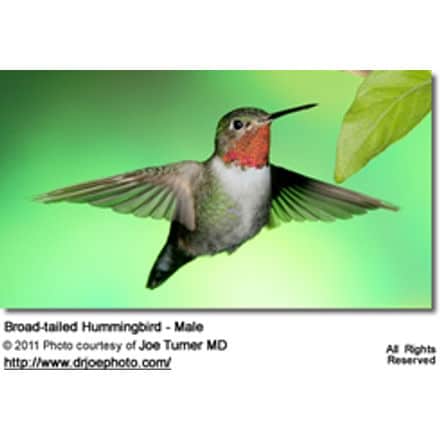
Calliope Hummingbirds (Stellula calliope) – Rare / Accidental – Occur in late fall, winter and early spring in Gulf Coast, Inland Coastal Plain, as well as the Mountain regions.
The smallest breeding bird in North America. They are most easily confused with the Rufous Hummingbirds and the Broad-tailed Hummingbird.
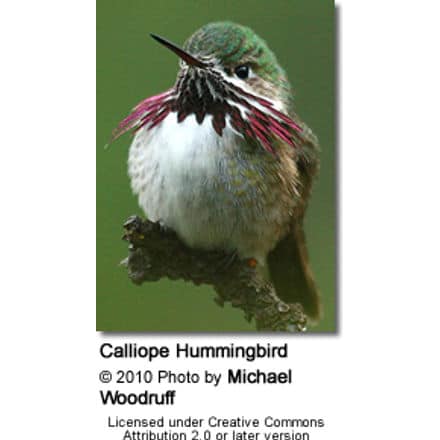
White-eared Hummingbirds (Basilinna leucotis) – Rare vagrants.
ID: Both the male and female White-eared Hummingbird have a prominent white ear stripe (more boldly colored in the male) for which this species was named.
The upper plumage and chest is mostly green and the undertail feathers whitish. The long, thin, straight bill is red at the base. The male has a turquoise throat, turquoise and white spotted chest and flanks, a deep green back, a white belly and chest.
The White-eared Hummingbird female has a white or cream colored throat that is speckled with green, a whitish belly, deep green crown and a drab green back.

